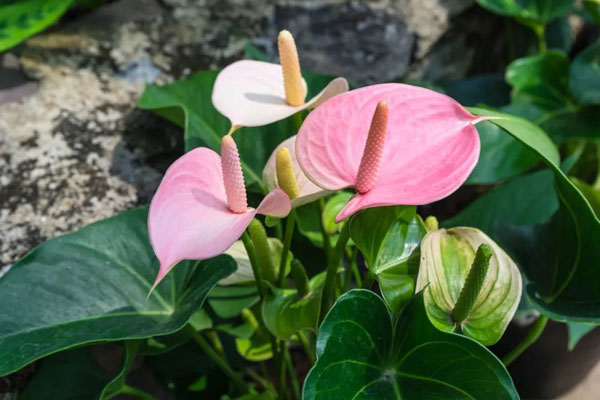Flamingo Flower: Grow & Care for Anthurium
Written by Iris
Oct 29 2021
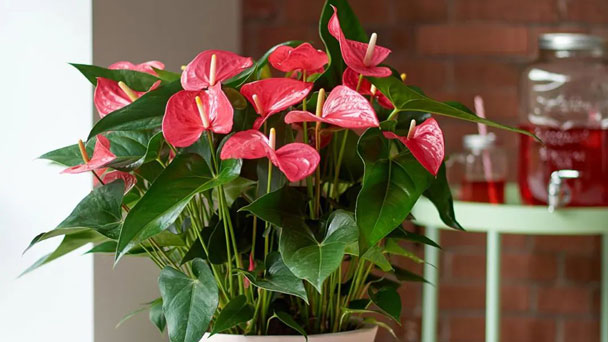
Flamingo Flower (Anthurium) is an annual herb with no obvious taproot, upright stems, no branches, and propagates by seeds. Flamingo Flower is native to Mexico and adjacent areas. There are many cultivated horticultural varieties. Currently, it is widely distributed in Africa, Asia (India, Laos, Cambodia, Vietnam, etc.), and Europe. The herb prefers a warm and sunny environment and flowers and fruits all year round.
When the berries are ready to fall off the spadix, collect them and squeeze the tiny fruits to reveal the seeds. Plant the seeds and any remaining bits of the berry in moist vermiculite or peat moss. Barely cover the seeds and then set the pots or seed-starting tray on a seed heat mat. Mist lightly and cover with plastic wrap or other clear covering to keep the seeds warm and moist.
After the seeds germinate in five to 14 days depending on the temperature and species, keep the seedlings in a warm, brightly lit location. Transplant to larger containers when they begin to outgrow their pots. Water regularly and mist as needed to keep the humidity high.
In four to five weeks, the cutting should produce new growth. Repot into a mix of peat moss, bark and perlite or combine equal parts cactus mix and orchid mix to make a quick-draining potting mix suited to these tropical epiphytes. Water when the soil is dry to the touch and mist the foliage regularly. Don't let the pot sit in water, as the roots will rot.
To divide the plant, carefully remove it from its container. Separate the root system into smaller sections. Each section should have at least one leaf and some healthy roots. While this can be done by hand, if you have trouble separating the root system use a sharp, clean knife.
Once you have divided the plant, plant each section in its own container. Water well and allow the plants to grow on as before.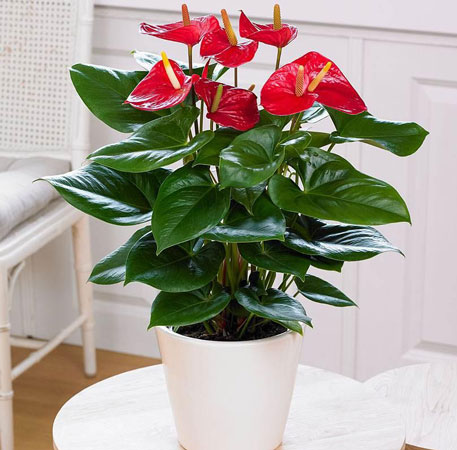
However, during winter when the plant goes into dormancy (growth slows), the anthurium will probably only require water about once every two weeks. The frequency you will need to water will depend on the individual conditions that you are growing your plant in, but you should get an idea of the pattern before too long.
Don't overwater or allow the pot to sit in standing water, as root rot can develop which can lead to the anthurium’s death. On the other hand, don't allow the soil to completely dry out, which can also lead to problems with the plant's growth and health.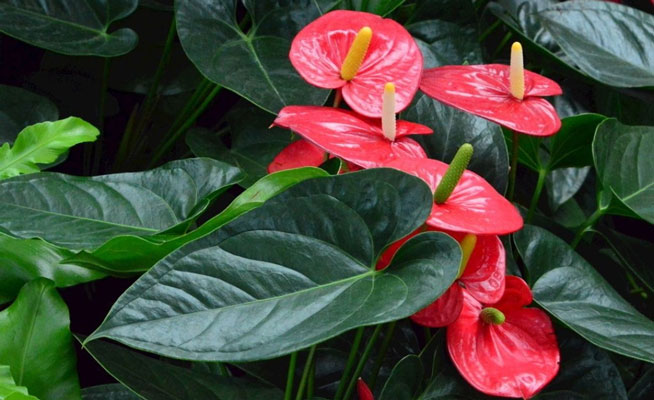
Flamingo Flower (Anthurium) doesn't require too much fertilizer – when the growing period starts, you can fertilize the plant only once a week. Once the winter arrives, you can stop with fertilizing entirely and continue with watering, and keeping the best conditions. Organic fertilizer is the best choice. If you don't care about using the organic ones, artificial is okay as well, but won't give as good results. The problem with artificial fertilizers is that you will need large amounts that won't give the plant a needed boost.
With a good organic fertilizer, using a smaller amount and fertilizing once a week is more than enough for a healthy plant to develop. Also, organic fertilizers might boost the development of flowers, so your painter's palette plant might even blossom.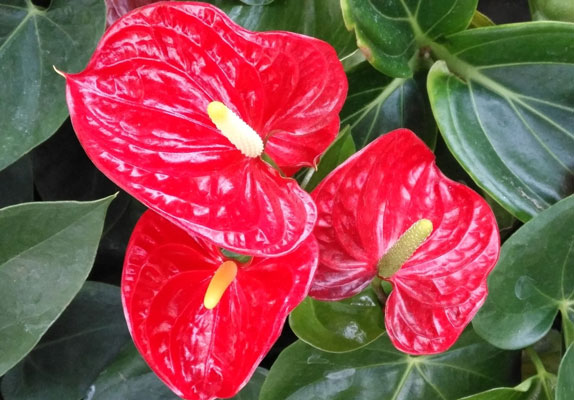
Anthurium andreanum: These feature heart-shaped leaves that grow up to 1 foot, with flowers available in red, white, pink, and variegated colors. They are distinguished by a straight flower spike.
Anthurium scherzerianum: The most forgiving of anthuriums, it features a curling orange flower spike and the leaves are arrow-shaped.
Anthuriums are collector's plants, and many of the most magnificent varieties are rarely found outside of greenhouses and botanical gardens. Other, less common species to consider include:
Anthurium crystallinum: These have deep green, velvety leaves with pronounced white ribs. The leaves grow up to 2 feet across.
Anthurium faustinomirandae: A monster-sized plant with cardboard-stiff leaves that grow up to 5 feet long. This is almost exclusively a greenhouse plant.
Anthurium crystallinum: These have deep green, velvety leaves with pronounced white ribs. The leaves grow up to 2 feet across.
Anthurium faustinomirandae: A monster-sized plant with cardboard-stiff leaves that grow up to 5 feet long. This is almost exclusively a greenhouse plant.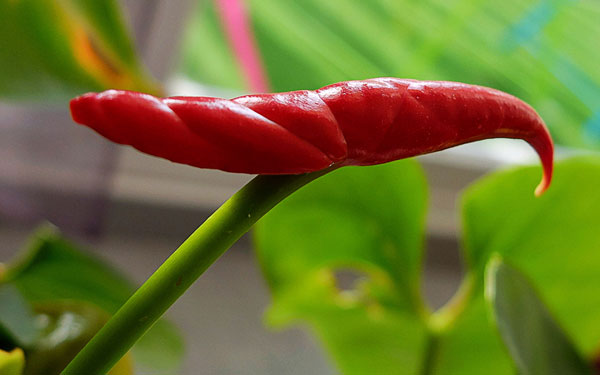
Understanding anthurium blooming habits will alleviate any unnecessary worries you might have that something is wrong with your plant. Mature anthuriums produce larger flowers and bloom more often throughout the year than immature plants.
Even the best cared for anthurium plant produces an average of about six flowers each blooming cycle, so don't expect your plant to be covered in blooms. The great thing about the blooms is they are long-lasting, staying colorful and perky for about 6-12 weeks. Even as cut flowers, anthurium blooms last about six weeks.
Read Next:
Best 15 Indoor Plants for Low Light 2021
How to Grow Flamingo Flower (Anthurium)Flamingo Flower Propagation with SeedsFlamingo Flower Propagation with Stem CuttingsFlamingo Flower Propagation with DivisionHow to Care for Flamingo Flower (Anthurium)Flamingo Flower Lighting RequirementsFlamingo Flower Soil CareFlamingo Flower WateringFlamingo Flower Temperature & Humidity CareFlamingo Flower FertilizerFlamingo Flower PruningFlamingo Flower Pests & Diseases CareFlamingo Flower VarietiesFlamingo Flower Care FAQIs Flamingo Flower Poisonous?Do Flamingo Flower Bloom Every Year?Why My Flamingo Flower Isn't Producing Many Blooms?
How to Grow Flamingo Flower (Anthurium)
Flamingo Flower Propagation with Seeds
Anthurium seeds are less common since the bright-yellow flowers on the spadix produce pollen and are receptive to fertilization at different times. If you have multiple flowers on one plant or on several different plants, you can use a paintbrush to collect the pollen from one and spread it over the flowers on the other spadix. It can take up to a year for the anthurium to produce its tiny seed-bearing berries.When the berries are ready to fall off the spadix, collect them and squeeze the tiny fruits to reveal the seeds. Plant the seeds and any remaining bits of the berry in moist vermiculite or peat moss. Barely cover the seeds and then set the pots or seed-starting tray on a seed heat mat. Mist lightly and cover with plastic wrap or other clear covering to keep the seeds warm and moist.
After the seeds germinate in five to 14 days depending on the temperature and species, keep the seedlings in a warm, brightly lit location. Transplant to larger containers when they begin to outgrow their pots. Water regularly and mist as needed to keep the humidity high.
Flamingo Flower Propagation with Stem Cuttings
Take a cutting with at least two nodes on the stem, preferably in spring or early summer. Dust the cut end with a fungicide and then insert it into sterile potting mix. Water and then put the pot and cutting into a plastic bag to increase humidity around the foliage. Place it in a warm location with bright, filtered light and water as needed to keep the potting mix moist but not waterlogged.In four to five weeks, the cutting should produce new growth. Repot into a mix of peat moss, bark and perlite or combine equal parts cactus mix and orchid mix to make a quick-draining potting mix suited to these tropical epiphytes. Water when the soil is dry to the touch and mist the foliage regularly. Don't let the pot sit in water, as the roots will rot.
Flamingo Flower Propagation with Division
Flamingo Flower Propagation is best done in early spring. The easiest way to propagate a Flamingo Flower (Anthurium) is by division. This method of propagation is best done in conjunction with repotting. As well as being a great way to acquire more plants, division also helps to control a plants growth habit.To divide the plant, carefully remove it from its container. Separate the root system into smaller sections. Each section should have at least one leaf and some healthy roots. While this can be done by hand, if you have trouble separating the root system use a sharp, clean knife.
Once you have divided the plant, plant each section in its own container. Water well and allow the plants to grow on as before.

How to Care for Flamingo Flower (Anthurium)
Flamingo Flower Lighting Requirements
Indoors, Flamingo Flower (Anthurium) thrive when placed in a location that receives medium to bright indirect light. However, during winter while the plant is dormant, they will tolerate receiving less light. Don't place the anthurium in an indoor location that receive bright, direct light especially during the afternoon or the foliage can burn. It is good to remember that in their native environment anthuriums grow beneath tree canopies and are protected from the direct rays of the sun.Flamingo Flower Soil Care
Flamingo flowers should be cultivated in loose, breathable, water-permeable soil that can maintain water and fertilizer. The best soil contains certain nutrients. You can choose leaf sapling soil or peat soil with some perlite or coal sand residue and base fertilizer to form vegetative soil. Some broken bricks can be added to the floor of the basin to facilitate drainage.Flamingo Flower Watering
Allow the top inch of soil to dry before watering an Flamingo Flower (Anthurium). Stick your finger into the potting mix about an inch and if it feels dry irrigate. Always water thoroughly until the water runs from the bottom drain holes. During the growing season of March through September, you can expect to water about once weekly. This gives the soil time to dry out before watering again.However, during winter when the plant goes into dormancy (growth slows), the anthurium will probably only require water about once every two weeks. The frequency you will need to water will depend on the individual conditions that you are growing your plant in, but you should get an idea of the pattern before too long.
Don't overwater or allow the pot to sit in standing water, as root rot can develop which can lead to the anthurium’s death. On the other hand, don't allow the soil to completely dry out, which can also lead to problems with the plant's growth and health.
Flamingo Flower Temperature & Humidity Care
Flamingo Flower (Anthurium) must have warm temperatures, so choose your plant's location carefully. No lower than 16°C / 60°F and for good growth 20°C / 68°F plus. If you can't meet the minimum temperature requirement all year round then ease up on the watering and feeding when it gets colder. The plant will need a reasonable level of humidity in order to thrive. The majority of homes should be suitable but if you've very dry air, regular misting will help, in addition to helping prevent dust from building up on the leaves.
Flamingo Flower Fertilizer
For plants to develop those stunning, vivid leaves, it will need some extra boost. Since it isn't growing in its natural conditions, some nutrients might be lacking. With the proper fertilizer, you will have a healthy Painter’s palette plant with the biggest and most colorful leaves.Flamingo Flower (Anthurium) doesn't require too much fertilizer – when the growing period starts, you can fertilize the plant only once a week. Once the winter arrives, you can stop with fertilizing entirely and continue with watering, and keeping the best conditions. Organic fertilizer is the best choice. If you don't care about using the organic ones, artificial is okay as well, but won't give as good results. The problem with artificial fertilizers is that you will need large amounts that won't give the plant a needed boost.
With a good organic fertilizer, using a smaller amount and fertilizing once a week is more than enough for a healthy plant to develop. Also, organic fertilizers might boost the development of flowers, so your painter's palette plant might even blossom.
Flamingo Flower Pruning
Flamingo Flower (Anthurium) require little regular pruning. Simply remove or cut away spent flowers to keep the plant looking neat and healthy. Damaged and dead foliage should also be removed.Flamingo Flower Pests & Diseases Care
Expect the typical houseplant issues of aphids, spider mites, scale, and mealy bugs. In many cases, a bit of insecticide can take care of infestation issues, as well as control of household humidity, temperature, and light levels.
Flamingo Flower Varieties
Common varieties sold as house plants include:Anthurium andreanum: These feature heart-shaped leaves that grow up to 1 foot, with flowers available in red, white, pink, and variegated colors. They are distinguished by a straight flower spike.
Anthurium scherzerianum: The most forgiving of anthuriums, it features a curling orange flower spike and the leaves are arrow-shaped.
Anthuriums are collector's plants, and many of the most magnificent varieties are rarely found outside of greenhouses and botanical gardens. Other, less common species to consider include:
Anthurium crystallinum: These have deep green, velvety leaves with pronounced white ribs. The leaves grow up to 2 feet across.
Anthurium faustinomirandae: A monster-sized plant with cardboard-stiff leaves that grow up to 5 feet long. This is almost exclusively a greenhouse plant.
Anthurium crystallinum: These have deep green, velvety leaves with pronounced white ribs. The leaves grow up to 2 feet across.
Anthurium faustinomirandae: A monster-sized plant with cardboard-stiff leaves that grow up to 5 feet long. This is almost exclusively a greenhouse plant.

Flamingo Flower Care FAQ
Is Flamingo Flower Poisonous?
This is another houseplant which contains calcium oxalate crystals in the leaves and stems. Whilst rarely fatal it can be very unpleasant when chewed on. Keep your pets away if they're the nibbling types.Do Flamingo Flower Bloom Every Year?
Anthurium flowers can last for more than three months and will produce new blooms all year round if given adequate light and care. Flamingo Flower (Anthurium) can live for years, and bloom again and again. They will produce fewer flowers in winter or if grown in a lower light location.Why My Flamingo Flower Isn't Producing Many Blooms?
If your Flamingo Flower (Anthurium) is happy with its growing conditions, is a mature plant that is blooming but just not producing an abundance of flowers, there's probably nothing wrong with it and it's flowering at a normal level of production for anthuriums.Understanding anthurium blooming habits will alleviate any unnecessary worries you might have that something is wrong with your plant. Mature anthuriums produce larger flowers and bloom more often throughout the year than immature plants.
Even the best cared for anthurium plant produces an average of about six flowers each blooming cycle, so don't expect your plant to be covered in blooms. The great thing about the blooms is they are long-lasting, staying colorful and perky for about 6-12 weeks. Even as cut flowers, anthurium blooms last about six weeks.
Read Next:
Best 15 Indoor Plants for Low Light 2021
Latest Updated
- Benefits of Bugleweed - 7 Science-backed Health Benefits
- Bugleweed Dangers & Side Effects - Is It Poisonous?
- How to Plant Evergreen Trees - What You Should Know
- When to Plant Evergreens - Grow Guide for Evergreen Trees
- 12 Wonderful Evergreen Shrubs for Your Garden
- 12 Popular Evergreen Plants with Pictures for Beginners
- When And How To Prune A Lilac Bush Like a Pro
- How to Grow & Care for Lilac Vine (Hardenbergia Violacea)
- Japanese Lilac Tree (Syringa Reticulata) Care & Propagation Guide
- Shumard Oak Pros and Cons - What to Know
Popular Articles
- Winter maintenance of Antirrhinum Majus
- How to Grow Terminalia Mantaly Tree
- How to Grow and Care for Crossostephium Chinense
- How to grow Antirrhinum Majus in spring
- Peristeria Elata (Dove Orchid) Profile: Info & Care Guide
- Underwatered Snake Plant (Sansevieria Trifasciata) - Signs And How To Fix
- How to Care for Brazilian Jasmine Plant (Mandevilla Sanderi)
- How to Grow & Care for Graptopetalum Purple Delight in Summer
- Rosa Chinensis (China Rose): Plant Growing & Care Tips
- How to Care for Baby Sun Rose (Aptenia Cordifolia)
